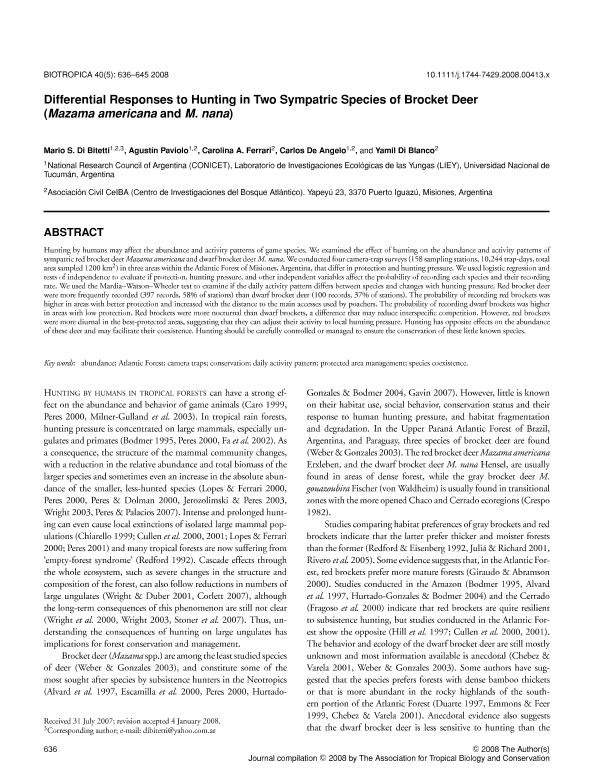Mostrar el registro sencillo del ítem
dc.contributor.author
Di Bitetti, Mario Santiago

dc.contributor.author
Paviolo, Agustin Javier

dc.contributor.author
Carolina A. Ferrari
dc.contributor.author
de Angelo, Carlos Daniel

dc.contributor.author
Di Blanco, Yamil Edgardo

dc.date.available
2018-09-28T17:49:59Z
dc.date.issued
2008-09
dc.identifier.citation
Di Bitetti, Mario Santiago; Paviolo, Agustin Javier; Carolina A. Ferrari; de Angelo, Carlos Daniel; Di Blanco, Yamil Edgardo; Differential responses to hunting in two sympatric species of brocket deer (Mazama americana and M. nana); Wiley Blackwell Publishing, Inc; Biotropica; 40; 5; 9-2008; 636-645
dc.identifier.issn
0006-3606
dc.identifier.uri
http://hdl.handle.net/11336/61238
dc.description.abstract
Hunting by humans may affect the abundance and activity patterns of game species. We examined the effect of hunting on the abundance and activity patterns of sympatric red brocket deer Mazama americana and dwarf brocket deer M. nana. We conducted four camera-trap surveys (158 sampling stations, 10,244 trap-days, total area sampled 1200 km2) in three areas within the Atlantic Forest of Misiones, Argentina, that differ in protection and hunting pressure. We used logistic regression and tests of independence to evaluate if protection, hunting pressure, and other independent variables affect the probability of recording each species and their recording rate. We used the Mardia-Watson-Wheeler test to examine if the daily activity pattern differs between species and changes with hunting pressure. Red brocket deer were more frequently recorded (397 records, 58% of stations) than dwarf brocket deer (100 records, 37% of stations). The probability of recording red brockets was higher in areas with better protection and increased with the distance to the main accesses used by poachers. The probability of recording dwarf brockets was higher in areas with low protection. Red brockets were more nocturnal than dwarf brockets, a difference that may reduce interspecific competition. However, red brockets were more diurnal in the best-protected areas, suggesting that they can adjust their activity to local hunting pressure. Hunting has opposite effects on the abundance of these deer and may facilitate their coexistence. Hunting should be carefully controlled or managed to ensure the conservation of these little known species. © 2008 The Author(s).
dc.format
application/pdf
dc.language.iso
eng
dc.publisher
Wiley Blackwell Publishing, Inc

dc.rights
info:eu-repo/semantics/openAccess
dc.rights.uri
https://creativecommons.org/licenses/by-nc-sa/2.5/ar/
dc.subject
Abundance
dc.subject
Atlantic Forest
dc.subject
Camera Traps
dc.subject
Conservation
dc.subject
Daily Activity Pattern
dc.subject
Protected Area Management
dc.subject
Species Coexistence
dc.subject.classification
Otras Ciencias Biológicas

dc.subject.classification
Ciencias Biológicas

dc.subject.classification
CIENCIAS NATURALES Y EXACTAS

dc.title
Differential responses to hunting in two sympatric species of brocket deer (Mazama americana and M. nana)
dc.type
info:eu-repo/semantics/article
dc.type
info:ar-repo/semantics/artículo
dc.type
info:eu-repo/semantics/publishedVersion
dc.date.updated
2018-09-18T14:07:35Z
dc.journal.volume
40
dc.journal.number
5
dc.journal.pagination
636-645
dc.journal.pais
Reino Unido

dc.journal.ciudad
Londres
dc.description.fil
Fil: Di Bitetti, Mario Santiago. Consejo Nacional de Investigaciones Científicas y Técnicas. Centro Científico Tecnológico Conicet - Nordeste. Instituto de Biología Subtropical. Instituto de Biología Subtropical - Nodo Posadas | Universidad Nacional de Misiones. Instituto de Biología Subtropical. Instituto de Biología Subtropical - Nodo Posadas; Argentina. Centro de Investigaciones del Bosque Atlántico; Argentina. Universidad Nacional de Tucumán; Argentina
dc.description.fil
Fil: Paviolo, Agustin Javier. Consejo Nacional de Investigaciones Científicas y Técnicas; Argentina. Universidad Nacional de Tucumán. Facultad de Ciencias Naturales e Instituto Miguel Lillo. Laboratorio de Investigaciones Ecológicas de las Yungas; Argentina. Centro de Investigaciones del Bosque Atlántico; Argentina
dc.description.fil
Fil: Carolina A. Ferrari. Consejo Nacional de Investigaciones Científicas y Técnicas; Argentina. Centro de Investigaciones del Bosque Atlántico; Argentina
dc.description.fil
Fil: de Angelo, Carlos Daniel. Consejo Nacional de Investigaciones Científicas y Técnicas; Argentina. Universidad Nacional de Tucumán. Facultad de Ciencias Naturales e Instituto Miguel Lillo. Laboratorio de Investigaciones Ecológicas de las Yungas; Argentina. Centro de Investigaciones del Bosque Atlántico; Argentina
dc.description.fil
Fil: Di Blanco, Yamil Edgardo. Consejo Nacional de Investigaciones Científicas y Técnicas; Argentina. Centro de Investigaciones del Bosque Atlántico; Argentina
dc.journal.title
Biotropica

dc.relation.alternativeid
info:eu-repo/semantics/altIdentifier/doi/http://dx.doi.org/10.1111/j.1744-7429.2008.00413.x
dc.relation.alternativeid
info:eu-repo/semantics/altIdentifier/url/https://onlinelibrary.wiley.com/doi/abs/10.1111/j.1744-7429.2008.00413.x
Archivos asociados
